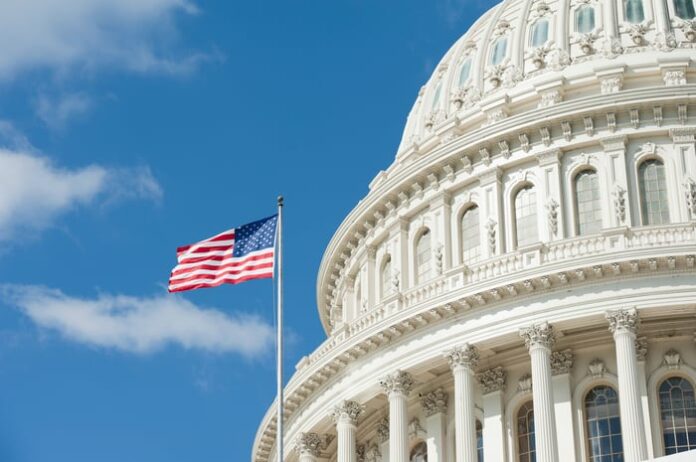Republicans Secure Senate Control: What This Means for Wall Street and Corporate Taxes
As the 2024 election draws near, American citizens are gearing up for a pivotal decision. The results will not only determine the next president but also reshape fiscal policies impacting the U.S. economy and businesses.
While scrutiny has largely focused on the presidential race — as of November 6 at 2:05 a.m. ET, former President Donald Trump has more than a 95% chance of winning, according to the Associated Press (AP) — the composition of Congress may signal even greater significance. Bills require support from both the House of Representatives and the Senate to pass.
In the early hours of the morning, AP reported that Republicans would regain control of the Senate starting January 3, 2025, which history suggests could bode well for Wall Street.

Image source: Getty Images.
Republicans Take Charge of the Senate
Even though the final results may take hours or days to finalize, Republicans have secured at least 51 seats in the 100-seat Senate, with several races still pending. This marks the GOP’s first control of the upper house in four years.
At this early stage, the implications of a Republican Senate on fiscal policy remain uncertain. If the GOP is also successful in the House and presidency, a unified government could streamline legislative processes. Conversely, if a split arises with Democrats controlling the House, political stalemate may ensue.
One point of clarity for Wall Street is the likelihood that corporate tax rates will remain stagnant at 21%. Democratic candidate Kamala Harris proposed raising this rate to 28% in order to generate revenue and address the federal deficit. A Republican majority in the Senate now greatly reduces the chances for such tax increases.
The low corporate tax rate has encouraged major companies to engage in substantial stock buybacks. Companies within the S&P 500 (SNPINDEX: ^GSPC) executed nearly $236 billion in share repurchases in the quarter ending June 2024, accumulating over $7 trillion in buybacks over the past ten years, according to S&P Global.

AAPL Stock Buybacks (Quarterly) data by YCharts.
For companies that experience stable or increasing net income, buybacks can significantly raise earnings per share (EPS). Since 2013, tech leader Apple (NASDAQ: AAPL) has spent over $700 billion on share buybacks, boosting its EPS. Similarly, Alphabet (NASDAQ: GOOGL)(NASDAQ: GOOG), Google’s parent company, reported over $271 billion in buybacks over the same period ending June 30, 2024.
Without fears of tax hikes in the near future, businesses may leverage the Republican control of the Senate to further increase their buybacks.

Image source: Getty Images.
Stock Performance Predictions with a Republican Senate
Investors are eager to understand the potential impact on stock markets with Republicans controlling the Senate. Historical data analyzed by Mike Patton, president of Integrity Wealth Management and Forbes contributor, suggest positive trends for investors.
Patton’s research shows that from 1946 to 2020, Republican-controlled Senate years yielded an average annual return of 11.3% for the Dow Jones Industrial Average (DJINDICES: ^DJI). In contrast, when Democrats held majority control, the average annual return dropped to 6.3% over the same time frame.
However, it’s important to note that regardless of party control in Congress or the presidency, the Dow has historically achieved positive annual returns from 1946 to 2020.
Investor patience remains a crucial factor in achieving success, transcending the ups and downs of political dynamics.
It’s official. A new bull market is confirmed.
The S&P 500 is now up 20% from its 10/12/22 closing low. The prior bear market saw the index fall 25.4% over 282 days.
Read more at https://t.co/H4p1RcpfIn. pic.twitter.com/tnRz1wdonp
— Bespoke (@bespokeinvest) June 8, 2023
As of June 2023, the researchers at Bespoke Investment Group highlighted the duration of bull and bear markets. The average S&P 500 bear market lasted about 286 calendar days, while bull markets spanned approximately 1,011 calendar days, or roughly 3.5 times as long. Notably, 14 out of 27 bull markets have persisted longer than the longest bear market.
When given time, America’s leading businesses tend to deliver results irrespective of the political landscape.
Considering a $1,000 Investment in the S&P 500 Index?
Before investing in the S&P 500 Index, it’s worth noting the insights from the Motley Fool Stock Advisor analyst team, who currently highlight 10 top stocks for investment — and the S&P 500 Index is not among them. These selected stocks have the potential for substantial returns in upcoming years.
For instance, when Nvidia was included in this list on April 15, 2005, a $1,000 investment would now be worth an astonishing $833,729!
Stock Advisor offers investors a straightforward approach to building portfolios, including regular market updates and fresh stock recommendations each month. Since 2002, the service has more than quadrupled the returns of the S&P 500.
See the 10 stocks »
*Stock Advisor returns as of November 4, 2024
Suzanne Frey, an executive at Alphabet, serves on The Motley Fool’s board. Sean Williams has stock positions in Alphabet. The Motley Fool has positions in and recommends Alphabet, Apple, and S&P Global. For disclosures, visit the Motley Fool’s website.
The views expressed here represent the author’s opinions and do not necessarily reflect those of Nasdaq, Inc.

